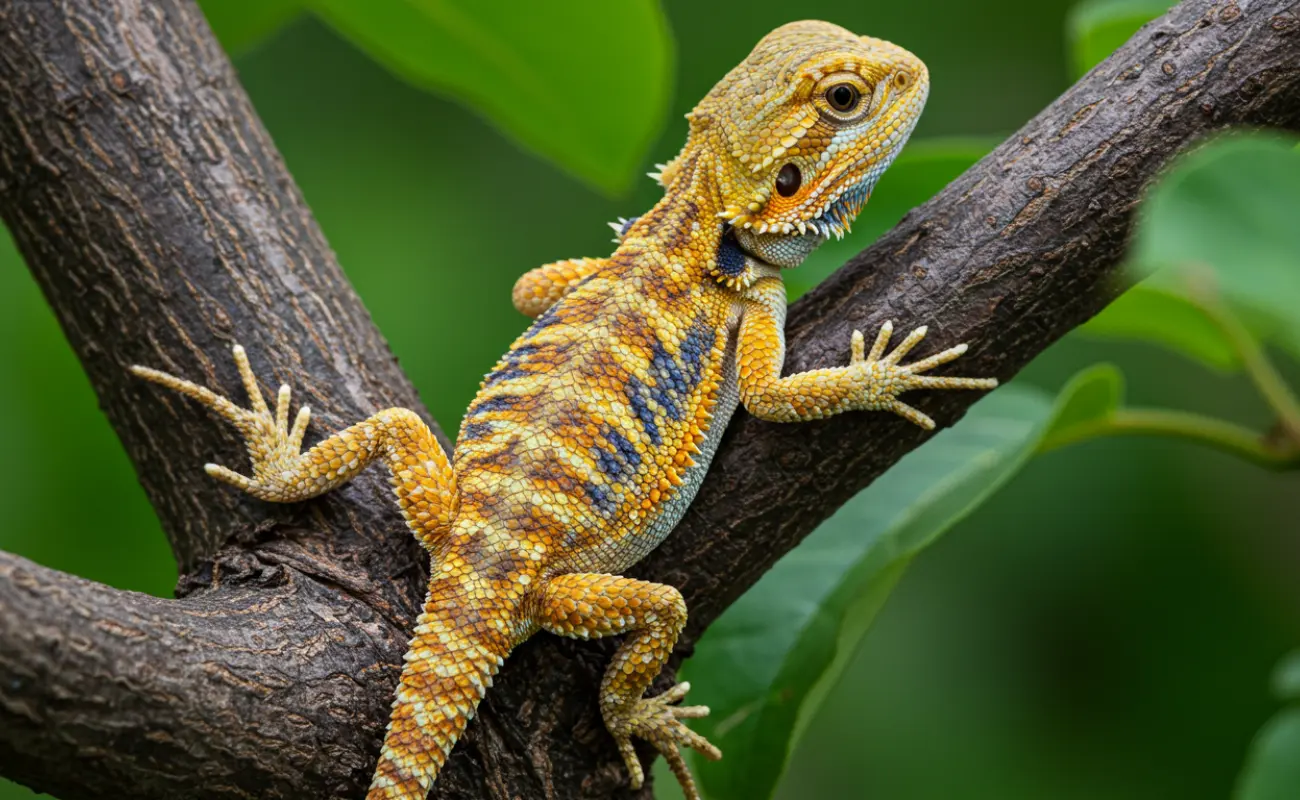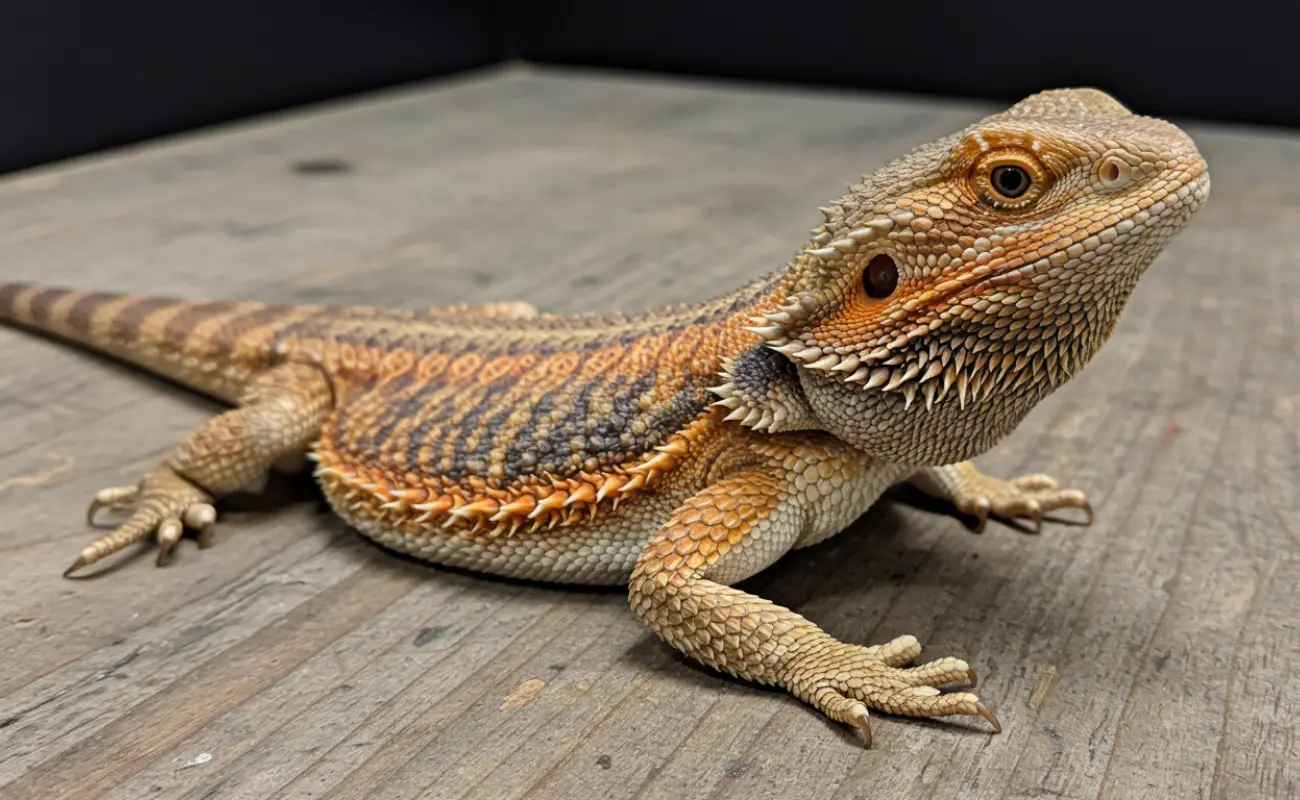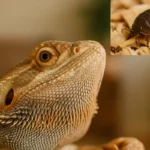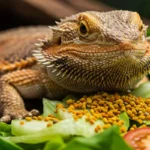If you’re searching for a bearded dragon that is visually striking and has an engaging personality, the Tiger Citrus Bearded Dragon could be your perfect pet. The Tiger Citrus Bearded Dragon is known for its vibrant colors, distinctive tiger-like stripes, and unique traits that make it one of the most popular and appealing morphs among reptile enthusiasts. In this article, we will explore everything you need to know about the Tiger Citrus Bearded Dragon, from its care requirements and size to its price and unique characteristics, providing you with a comprehensive guide whether you’re an experienced herpetologist or a first-time reptile owner.
Tiger Citrus Bearded Dragon Care
Proper care for your Tiger Citrus Bearded Dragon is crucial to ensure a long and healthy life. Here’s what you need to provide:
-
Enclosure: A minimum 40-gallon tank for adults is necessary, with a temperature gradient ranging from 88°F-100°F (basking) to 75°F-85°F (cool side). A tank this size will allow for ample space to move around comfortably.
-
UVB Lighting: Essential for synthesizing vitamin D3, which is critical for bone health and helps prevent metabolic bone disease. UVB lights should be on for approximately 12 hours per day.
-
Diet: As omnivores, Tiger Citrus Bearded Dragons require a balanced diet consisting of both insects (such as crickets, mealworms, superworms, and Dubia roaches) and leafy vegetables like collard greens, squash, and bell peppers. Calcium supplementation is important for preventing metabolic bone disease.
-
Humidity: Maintain low humidity levels between 30% and 40% to replicate their natural desert environment. This also aids in proper shedding and overall skin health.
-
Routine Maintenance: Regular cleaning, a proper lighting schedule, and annual veterinary checks are essential for ensuring the dragon’s optimal health and wellbeing.
For more detailed care advice, refer to our article on Can Bearded Dragons Eat Beetles? Safe Types, Risks & Expert Advice.
Tiger Citrus Bearded Dragon Size
Tiger Citrus Bearded Dragons typically reach adult sizes ranging from 18 to 24 inches, with males slightly larger than females. Juvenile dragons grow quickly and can reach 10 to 12 inches in their first year, with full adult size achieved between 12 to 18 months, depending on diet and care.
Tiger Citrus Bearded Dragon Price
The price of a Tiger Citrus Bearded Dragon can range from $100 to $250. This price varies depending on factors such as coloration intensity, lineage, size, and any additional genetic traits, such as Translucent or Hypo traits. Juveniles generally cost less, while adults exhibiting vibrant and unique traits tend to be on the higher end of the price spectrum. Additionally, adoption from shelters or rescues may offer a more affordable option, with prices ranging between $40 to $100.
Tiger Citrus Bearded Dragon vs Bearded Dragon
When comparing the Tiger Citrus Bearded Dragon to a standard Bearded Dragon, several notable differences emerge:
-
Appearance: The Tiger Citrus Bearded Dragon has vibrant yellow or gold colors with distinctive tiger stripes, whereas the standard Bearded Dragon typically presents more muted browns, tans, or oranges without the bold stripe pattern.
-
Price: Regular Bearded Dragons usually cost between $50 and $100, while Tiger Citrus Dragons range from $100 to $250 due to their enhanced coloration and striking patterns.
-
Personality and Care: Both types share similar temperaments—docile, friendly, and interactive—making them excellent pets for both beginners and experienced keepers. The care requirements for both types are virtually identical, emphasizing the importance of providing an adequate space, proper UVB lighting, temperature control, and a balanced diet.
Citrus Tiger Bearded Dragon Baby
Young Citrus Tiger Bearded Dragons are captivating right from the start with their striking, bright yellow coloration accented by faint blue undertones from the Translucent trait. These hues are most vivid during their juvenile stages, creating a highly attractive appearance. Proper nutrition is critical at this growth stage to ensure vibrant color development and overall health. A diet rich in protein—primarily consisting of gut-loaded insects like crickets, mealworms, and dubia roaches—is essential. Equally important is the inclusion of calcium-supplemented vegetables, such as kale, collard greens, and bell peppers, to support strong bone growth and healthy scales. Regular exposure to appropriate UVB lighting will enhance their natural colors and facilitate vitamin D3 synthesis, crucial for metabolic processes.

Orange Citrus Tiger Bearded Dragon
The Orange Citrus Tiger Bearded Dragon is a breathtaking morph known for its dazzling mixture of vibrant orange tones interwoven with classic tiger stripes. This particular morph is highly sought after for its fiery appearance, reminiscent of a stunning desert sunset. These dragons are visually impressive, with orange hues that range from bright tangerine to deep burnt orange, intensified by contrasting dark stripes. Like other Tiger Citrus morphs, maintaining their striking coloration requires diligent care. A balanced diet rich in colorful vegetables and quality insects, consistent UVB lighting, and proper thermal gradients within their enclosure are necessary to maintain optimal health and vibrant coloration.
Red Citrus Tiger Bearded Dragon
Red Citrus Tiger Bearded Dragons are particularly admired for their stunning, deep red or maroon stripes set against a contrasting yellowish or gold base. This striking coloration makes them a favorite among collectors and enthusiasts looking for a dragon with dramatic visual appeal. The intensity of the red coloring typically increases as these dragons mature, provided they receive optimal care conditions. Ensuring consistent husbandry—including proper enclosure temperatures, adequate UVB lighting, and a nutrient-rich diet with ample supplementation—will significantly enhance and preserve their dramatic red coloring.
Yellow Citrus Tiger Bearded Dragon
The Yellow Citrus Tiger Bearded Dragon is beloved for its vivid, cheerful yellow-gold coloration, often compared to the vibrant hues of lemon or gold. This morph is among the most common yet cherished due to its bright and appealing appearance, maintaining its vibrant shades throughout its lifetime with proper care. Providing sufficient UV exposure, maintaining appropriate habitat conditions, and ensuring a diet rich in insects, leafy greens, and calcium supplementation are critical to preserving and enhancing the brilliant yellow pigmentation inherent to this morph.
Hypo Trans Citrus Tiger Bearded Dragon
The Hypo Trans Citrus Tiger Bearded Dragon stands out exceptionally due to its unique genetic combination. This morph combines two fascinating traits:
- Hypomelanistic (Hypo): This genetic trait significantly reduces the production of dark pigments, resulting in a brighter, more vibrant appearance that accentuates the underlying colors.
- Translucent (Trans): Dragons with this trait exhibit a semi-transparent, slightly bluish tint to their scales, most noticeable during their juvenile phase. Many also feature captivating solid black eyes.
This striking combination of traits makes the Hypo Trans Citrus Tiger Bearded Dragon highly prized among collectors, often commanding premium prices due to its visual appeal and rarity. Providing proper care through optimal diet, UVB lighting, and habitat conditions ensures these unique dragons retain their stunning appearance throughout their life.

Citrus Blue Tiger Bearded Dragon
The Citrus Blue Tiger Bearded Dragon morph exhibits an extraordinary combination of vibrant citrus yellow colors with an alluring subtle blue hue, thanks to the Translucent genetic trait. This mesmerizing blue coloration is more pronounced in juveniles, creating a remarkable visual effect. As these dragons mature, the intensity of the blue tends to fade but leaves behind an attractive, subtle tint that continues to captivate enthusiasts. The rarity and visual uniqueness of this morph typically result in higher market prices compared to more common variants. Proper care, emphasizing balanced nutrition, consistent UVB exposure, and carefully maintained environmental conditions, will help ensure that these dragons remain healthy and visually stunning.
Frequently Asked Questions (FAQ)
What is the lifespan of a Tiger Citrus Bearded Dragon?
Tiger Citrus Bearded Dragons typically live between 10-15 years with proper care.
Can Tiger Citrus Bearded Dragons live together?
It’s best to house them separately to prevent aggression. Dragons of similar size and temperament may occasionally be housed together under close supervision.
What diet is best for a Tiger Citrus Bearded Dragon?
A balanced diet consisting of insects and leafy greens, supplemented with calcium, is optimal for maintaining health and vibrant colors.
Are Tiger Citrus Bearded Dragons friendly?
Yes, they are known for their docile and friendly temperament, making them excellent pets for both beginners and experienced keepers.
How often do Tiger Citrus Bearded Dragons need UVB exposure?
They require approximately 12-14 hours of UVB light daily to maintain optimal health.
Conclusion
The Tiger Citrus Bearded Dragon offers an incredible variety of stunning coloration and patterns, including captivating morphs such as orange, red, yellow, hypo trans, and blue. Beyond their visual appeal, these dragons are celebrated for their friendly and docile nature, making them outstanding pets for reptile enthusiasts of all experience levels. Proper care—including suitable housing, a balanced diet, and consistent UVB lighting—is essential to ensuring your Tiger Citrus Bearded Dragon thrives, providing years of companionship and enjoyment. Engage with reputable breeders to discover and welcome your perfect reptilian companion today!





